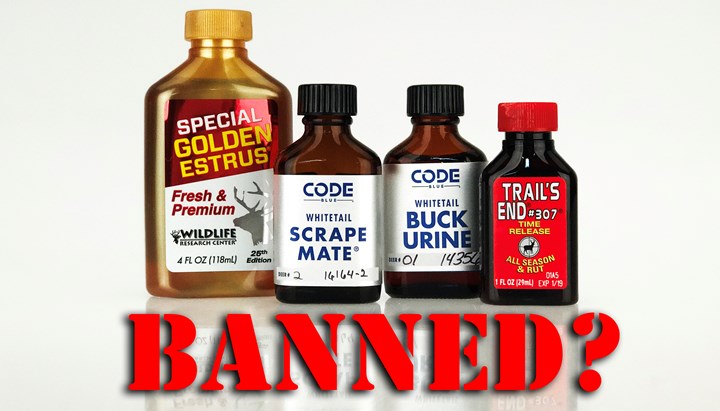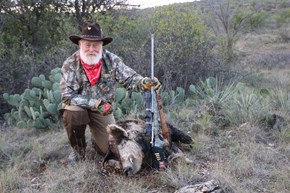
by Larry L. Weishuhn, wildlife biologist and outdoor TV host - Monday, September 25, 2017

Chronic wasting disease (CWD) continues to concern wildlife managers and hunters across North America and parts of Europe. Research suggests the prions which cause CWD can be spread to unaffected deer through saliva and body fluids. This has prompted several states and Canadian provinces to either ban or limit the use of baits and other deer attractants which may concentrate deer. This is also causing some states and Canadian provinces to question the use of deer urine-based attractants by deer hunters.
Researchers and wildlife managers first became aware of CWD about 50 years ago when it appeared in elk in northeastern Colorado. Today it has spread to at least 21 different states. In spite of many sophisticated research projects regarding CWD, there is still much to be learned about the disease.
Research on this unique disease caused by prions, which cannot be destroyed by extreme cold, extreme heat or antibiotics, unlike bacteria or viruses, is ongoing and will continue well into the future. Questions and research continue to arise regarding how best to prevent the spread of the disease and how to deal with it where it already exists.
One of the questions that has recently come to the forefront is: Can the use of deer urine-based attractant scents spread the disease? The use of these deer urine-based attractants, such as doe-in-heat and other deer scents, is widespread throughout the whitetail deer’s range.
One of the states to recently consider a ban of deer urine-based attractants is New York. Hunters and interested parties will have until Sept. 15 to express their opinions at hearings, after which a long-term decision will be made. States where a ban of these products is already in effect include Alaska, Arkansas, Arizona, Virginia and Vermont, as well as the Canadian provinces of Manitoba and Ontario. Minnesota has imposed a ban in effect on a small wildlife management area in the southeastern part of the state while Pennsylvania has a ban in effect in some counties.
One of the serious concerns about CWD is the very slow nature of the disease to show its impact or presence. Development of the disease can take months, if not years. We must consider that the correctness or incorrectness of decisions made today may not be apparent until long into the future.
We hunter/conservationists care deeply about whitetail deer and their well being. We must ask, “Can CWD be transmitted and spread through deer urine-based scents?” Decisions regarding a ban or no ban must be based on research rather than conjecture or supposition.
Researchers N.J. Haley, D.M. Seelig, G.C. Telling and E.A. Hoover reported their research findings in a paper titled, “Detection of CWD Prions in Urine and Saliva of Deer by Transgenic Mouse Bioassay” published in the Public Library of Science (PLOS.org), PLoS ONE Journal. “Urine from even clinically (CWD) sick deer must be concentrated in order to produce a sufficient number of prions to even test. Urine from clinically sick animals was concentrated 10 times greater than normal and then injected directly into the brains of test subjects. Even under these experimental conditions that were extremely unnatural, only one of the 10 subjects injected became infected by CWD.”
After doing research, scientists Nicholas Haley, DVM (Doctor of Veterinary Medicine), PhD, at Midwestern University’s Department of Microbiology and Immunology and David Henderson, PhD, at Colorado State University’s Department of Microbiology, Immunology and Pathology shared their findings. They publicly stated, “Of those deer urine-based companies that follow the ATA Deer Protection Program Producers’ guideline in producing their attractants, the risk of urine-based scents spreading CWD is virtually zero!”
In a study conducted by Dr. Candice Mathiason and others at the Prion Research Center at Colorado State University, published in PLOS.org’s PLoS ONE Journal, 90 daily doses of urine and feces from CWD-infected deer were put into deer not previously exposed to the disease. These experimentally-exposed deer showed no sign of the disease 15 months after exposure.
Based on these research projects, CWD is not spread by deer urine or deer urine-based attractants, except under extremely unnatural and concentrated conditions. Even then, only a small percentage became infected.

If you use deer urine-based scents, look for those produced by companies participating in the Archery Trade Association’s (ATA) Deer Protection Program. These operations adhere to extremely high standards and are frequently monitored to prevent any problems with CWD. Those that live by those strict guidelines have the ATA Deer Protection Program Participant logo on their labeling. The 21 participating manufacturers to date include the Wildlife Research Center, Robinson Outdoor Products, Hunter Specialties and Code Blue. For a complete list of participating manufacturers, click here.
What can you as a hunter do to insure the use of deer urine-based scents now and in the future? Contact your respective state wildlife agency, call your state representative and attend public hearings to express your opinion.
■ ■ ■
About the Author
Legendary “Mr. Whitetail,” Larry Weishuhn, host and owner of DSC's "Trailing the Hunter's Moon," is one of the most popular and widely-recognized wildlife biologists and outdoor media personalities nationwide. Over the past five decades, he has authored multiple books and numerous articles on hunting and wildlife conservation. In his 2004 book, Trailing the Hunter's Moon, was named Foreword Magazine's Gold Book of the Year in the Adventure and Recreation category.
Over the past five decades, he has authored multiple books and numerous articles on hunting and wildlife conservation. In his 2004 book, Trailing the Hunter's Moon, was named Foreword Magazine's Gold Book of the Year in the Adventure and Recreation category.
A lifelong hunter, Weishuhn has long served as a featured speaker for the NRA and other organizations including Dallas Safari Club (DSC) and the Texas Wildlife Association (TWA), where he was one of three co-founders promoting science-based wildlife management, firearms and hunting. For more information, click here.
E-mail your comments/questions about this site to:
[email protected]
